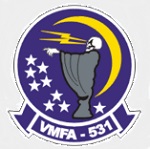Hobby Master HA19014 USMC McDonnell F-4N Phantom II Fighter-Bomber - 15323, VMFA-531 "Grey Ghosts", USS Coral Sea (CV-43), 1965 (1:72 Scale)
"Grey Ghosts"
- Nickanme of VMFA-531
 The McDonnell Douglas F-4 Phantom II is a two-seat, twin-engined, all-weather, long-range supersonic fighter-bomber originally developed for the U.S. Navy by McDonnell Aircraft. Proving highly adaptable, it became a major part of the air wings of the U.S. Navy, Marine Corps, and U.S. Air Force. It was used extensively by all three of these services during the Vietnam War, serving as the principal air superiority fighter for both the Navy and Air Force, as well as being important in the ground-attack and reconnaissance roles by the close of U.S. involvement in the war.
The McDonnell Douglas F-4 Phantom II is a two-seat, twin-engined, all-weather, long-range supersonic fighter-bomber originally developed for the U.S. Navy by McDonnell Aircraft. Proving highly adaptable, it became a major part of the air wings of the U.S. Navy, Marine Corps, and U.S. Air Force. It was used extensively by all three of these services during the Vietnam War, serving as the principal air superiority fighter for both the Navy and Air Force, as well as being important in the ground-attack and reconnaissance roles by the close of U.S. involvement in the war.
First entering service in 1960, the Phantom continued to form a major part of U.S. military air power throughout the 1970s and 1980s, being gradually replaced by more modern aircraft such as the F-15 Eagle and F-16 Fighting Falcon in the U.S. Air Force and the F-14 Tomcat and F/A-18 Hornet in the U.S. Navy. It remained in service in the reconnaissance and Wild Weasel roles in the 1991 Gulf War, finally leaving service in 1996. The Phantom was also operated by the armed forces of 11 other nations. Israeli Phantoms saw extensive combat in several Arab-Israeli conflicts, while Iran used its large fleet of Phantoms in the Iran-Iraq War. Phantoms remain in front line service with seven countries, and in use as an unmanned target in the U.S. Air Force.
Phantom production ran from 1958 to 1981, with a total of 5,195 built. This extensive run makes it the second most-produced Western jet fighter, behind the famous F-86 Sabre at just under 10,000 examples.
The F-4 Phantom was designed as a fleet defense fighter for the U.S. Navy, and first entered service in 1960. By 1963, it had been adopted by the U.S. Air Force for the fighter-bomber role. When production ended in 1981, 5,195 Phantom IIs had been built, making it the most numerous American supersonic military aircraft. Until the advent of the F-15 Eagle, the F-4 also held a record for the longest continuous production for a fighter with a run of 24 years. Innovations in the F-4 included an advanced pulse-doppler radar and extensive use of titanium in its airframe.
Despite the imposing dimensions and a maximum takeoff weight of over 60,000 pounds (27,000 kg), the F-4 had a top speed of Mach 2.23 and an initial climb of over 41,000 ft per minute (210 m/s). Shortly after its introduction, the Phantom set 15 world records, including an absolute speed record of 1,606.342 mph (2,585.086 km/h), and an absolute altitude record of 98,557 ft (30,040 m). Although set in 1959-1962, five of the speed records were not broken until 1975 when the F-15 Eagle came into service.
The F-4 could carry up to 18,650 pounds (8,480 kg) of weapons on nine external hardpoints, including air-to-air and air-to-ground missiles, and unguided, guided, and nuclear bombs. Since the F-8 Crusader was to be used for close combat, the F-4 was designed, like other interceptors of the day, without an internal cannon. In a dogfight, the RIO or WSO (commonly called "backseater" or "pitter") assisted in spotting opposing fighters, visually as well as on radar. It became the primary fighter-bomber of both the Navy and Air Force by the end of the Vietnam War.
Due to its distinctive appearance and widespread service with United States military and its allies, the F-4 is one of the best-known icons of the Cold War. It served in the Vietnam War and Arab-Israeli conflicts, with American F-4 crews achieving 277 aerial victories in Southeast Asia and completing countless ground attack sorties.
Pictured here is a 1:72 scale replica of a USMC McDonnell F-4N Phantom II fighter-bomber that was attached to VMFA-531 "Grey Ghosts", then embarked upon the USS Coral Sea (CV-43) during 1965.
Sold Out!
Dimensions:
Wingspan: 6-1/4-inches
Length: 10-1/2-inches
Release Date: April 2020
 Historical Account: "Grey Ghosts" - Marine Fighter Attack Squadron 531 (VMFA-531) was a United States Marine Corps fighter squadron consisting of F/A-18 Hornets. Known as the "Grey Ghosts", the squadron participated in action during World War II and the Vietnam War. They were decommissioned on March 27th, 1992.
Historical Account: "Grey Ghosts" - Marine Fighter Attack Squadron 531 (VMFA-531) was a United States Marine Corps fighter squadron consisting of F/A-18 Hornets. Known as the "Grey Ghosts", the squadron participated in action during World War II and the Vietnam War. They were decommissioned on March 27th, 1992.
On April 10th, 1965, 15 F-4Bs from the squadron arrived at Da Nang Air Base, South Vietnam, becoming the first land-based Marine Corps jets during the Vietnam War. They immediately began flying bombing missions under radar guidance and standard close air support missions in support of Marines on the ground.







![RAF BAe Harrier GR9A Jump Jet - ZG506/P77 "Ninja 1", Cottesmore Wing, RAF Cottesmore, England, December 15th, 2010 [Commemorative Scheme] (1:48 Scale)](http://cdn4.volusion.store/qh9e9-jdqv9/v/vspfiles/photos/AA29302-1.jpg?v-cache=1740197136)

